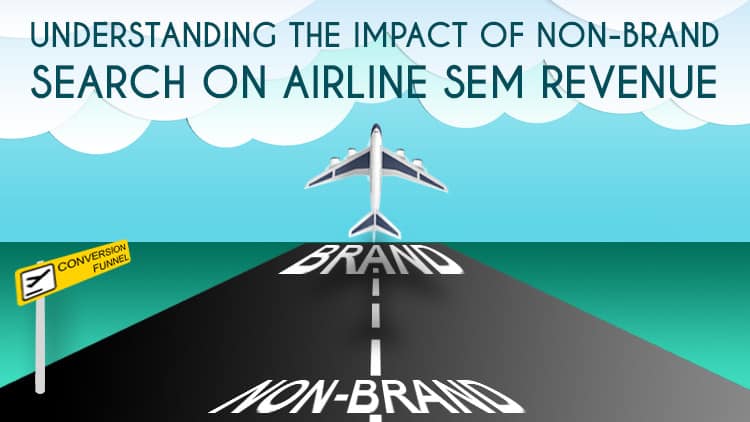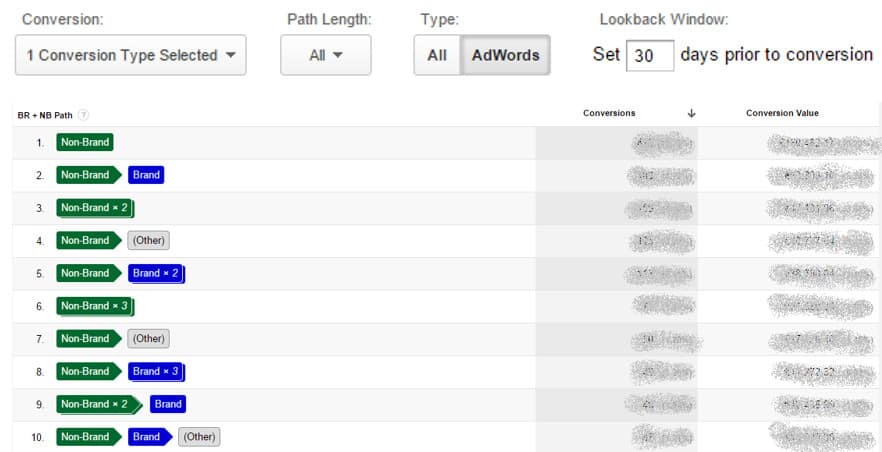A typical airline report on SEM performance will show that the majority of revenue is generated by branded search queries (e.g., “american airlines flights”). Because Google Adwords attributes conversions back to the campaign that was last clicked, airline marketers must still determine how a flight searcher arrived at that brand query and ad—what was the “conversion path?” Analysis reveals that non-branded* searches play a definite role in driving brand searches, new customer acquisition and revenue generation, impacting numerous channels. Using Top Conversion Path and Assisted Conversion Analysis can help determine the impact and value of Non-Brand Campaigns for airlines.
*At EveryMundo, “Non-Brand” generally refers to campaigns targeting keywords containing origin and/or destination terms without an airline’s brand (e.g. “flights to miami”).
Top Conversion Paths
The “Top Conversion Paths” report in Google Analytics shows all unique conversion paths that lead to a transaction, the number of conversions from each path, and the value of those conversions. You can follow these steps to analyze the report:
1. Create a “custom channel grouping” by defining a channel for SEM Brand Campaigns and another channel for SEM Non-Brand Campaigns. A consistent and organized naming structure within your SEM accounts will facilitate this segmentation.
2. Summarize conversions and conversion value on a last-click basis, as follows:
a) If Non-Brand was the last Adwords campaign touched, the attribution goes towards Non-Brand.
b) If Brand was the last Adwords campaign touched, the attribution goes towards Brand.
c) If Brand was preceded by Non-Brand, the attribution counts towards Non-Brand + Brand.
d) If Non-Brand was preceded by Brand, the attribution counts towards Non-Brand.
For example:
Note that (Other) means that the customer used a different medium, such as Organic Search, to enter the website immediately preceding conversion.
Assisted Conversions
The assisted conversions report shows how many conversions each channel initiated, assisted and completed, and the value of those conversions. For this analysis, “Assisted/Last Click or Direct Conversions” is a useful metric.
Google explains how to interpret this metric: “a value close to 0 indicates that a channel completed more sales and conversions than it assisted. A value close to 1 indicates that the channel equally assisted and completed sales and conversions. The more this value exceeds 1, the more the channel assisted sales and conversions.”
Using the same settings as for the analysis of the Top Conversion Path, the report may look like this:
One can see based on this example that Non-Brand campaigns are contributing to significantly more conversions farther down the conversion path than what they appear to generate on a last-click basis. It is also important to note that this analysis only considers the conversion path within a 30-day “look back window.” That is, the impact of Non-Brand and Brand is only visible for 30 days prior to the conversion.
Case Study
Cost-Conscious Airline 1: Paid Search Spend Distribution 60% Brand vs. 40% Non-Brand (2014)
| Campaign Type | Revenue |
| Brand | 92% |
| Non-Brand | 6% |
| NB+BR | 2% |
| Assisted/Direct | 2.9 |
Looking at assisted/direct conversions, the impact of Non-Brand is nearly triple what is apparent from last-click attribution.
Growth Oriented Airline 2: Paid Search Spend Distribution 20% Brand vs. 80% Non-Brand (2014)
| Campaign Type | Revenue |
| Brand | 87% |
| Non-Brand | 8% |
| NB+BR | 5% |
| Assisted/Direct | 2.3 |
Looking at the same metric here, the real impact of Non-Brand is more than double what a last-click attribution model would imply.
Although both airlines earned more revenue from branded searches, the impact of Non-Brand search on Brand conversions is not accurately depicted if campaigns are analyzed solely on a last-click basis, which could lead to misallocation of budget and stifle growth.
Closing Thoughts
The Top Conversion Paths report is a powerful tool for understanding the impact of Non-Brand campaigns in the overall SEM strategy. The true value of non-branded terms will continue to be a widely discussed topic considering that branded terms outperform and drive more revenue on a last-click basis, which is unlikely to change any time soon. However, airlines need to understand how the average consumer interacts with their brand before booking a flight on the website.
It is clear that for an airline that has allocated more of its budget towards Non-Brand, the influence of non-branded searches resulting in branded conversions will be higher. Therefore, even a cost-conscious airline might consider shifting more budget towards more Non-Brand activity to drive growth and acquire new customers who are not yet brand loyal. However, before making that decision or deciding upon the appropriate budget allocation, an airline must first understand the impact Non-Brand search is having on their Brand revenue.
However, actual performance of these channels and their mutual interaction will depend on the specifics of an airline’s network, brand recognition, competitive environment and many other factors. Therefore, performing detailed analysis with the help of these two reports will be an essential step in evaluating if greater investment in Non-Brand paid search makes sense within the context of your airline’s larger digital marketing strategy.
By: [post_authors_post_link]




